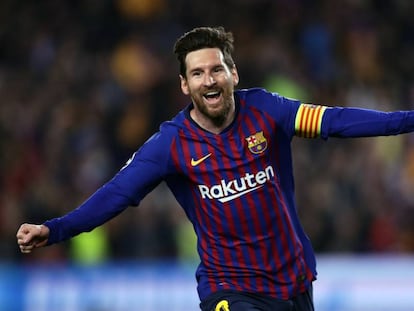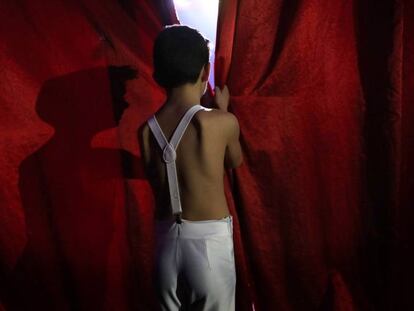How Cirque du Soleil turned to the genius of Messi for inspiration
The artistic spirit of the Argentine soccer star is the protagonist of the world-renowned company’s new production. EL PAÍS SEMANAL got a sneak peek at the rehearsals in Montreal ahead of the premiere on October 10 in Barcelona
A red-and-white ball was the gift that Lionel Messi received on his fourth birthday, on June 24, 1991. A legend was born at that precise moment, as he reportedly proceeded to execute a series of mind-blowing moves with his present. “We froze when we saw all the things he knew how to do, because he had never played soccer before,” says his father, Jorge, in Luca Caioli’s biography, Messi.
Messi’s instinctive handling of the ball led to fame at an early age. During the half-time breaks at matches played by the Newell’s Old Boys club, his name would be called out and Messi, standing barely one meter tall, would descend the stairs of Coloso del Parque stadium without once dropping the ball from his feet. It is this artistic spirit that Cirque du Soleil has captured in its groundbreaking show Messi10, which is due to open in Barcelona on October 10.
“Leo is the best in the world and we want to represent his skills on the pitch – his strength and determination,” says Mukhtar Omar Sharif, the show’s director. “But we are still a circus and this a show for everyone, not just for soccer lovers.”
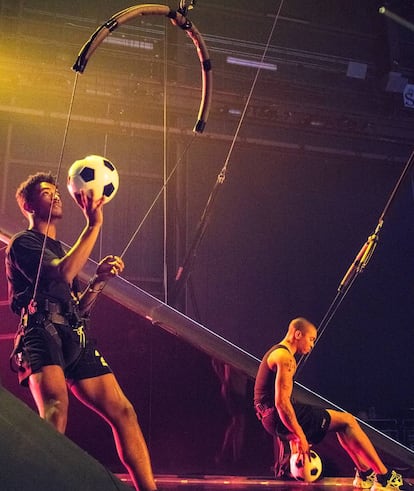
The idea for the production originally came from José Manuel Pinto, a former Barcelona goalkeeper and founder of Wahin Makinaciones Records, who also happens to be an artist with Sony and a great friend of Messi’s. “I always believed there were a lot of parallels between music and sport and that they fed into each other,” says Pinto, who is now a sound engineer.
Pinto took the idea to Afo Verde, president of Sony Latin America, Spain and Portugal, who had already collaborated with Cirque du Soleil on earlier projects. “What if we do a show and combine it with soccer?” ventured Pinto.
The Sony CEO was excited: “Yes, we could tell the story of someone like Michael Jackson or The Beatles,” he replied. At which point, Pinto interjected with, “Well, I have a friend who is the greatest of them all and he’s still alive. It would be great to do it with someone who is still living.” And the CEO agreed: “It would be fabulous!”
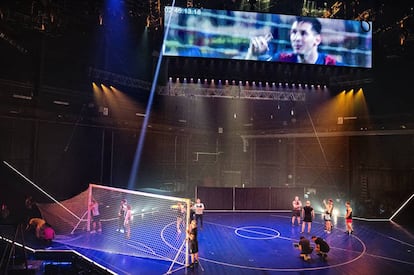
Days later, Verde was at the Camp Nou stadium along with the Cirque du Soleil directors to watch Messi in action and get some ideas together for the extravaganza.
But while the proposal started to take shape, it still needed Messi’s approval. “I went to see him and explained the idea,” says Pinto. “I knew he would like it because we had gone to see it [Cirque du Soleil] with our families.”
As Pinto had anticipated, Leo was all for it, though he was anxious to know how the two different skill sets could be woven together.

“Messi has followed the show and its developments closely,” says the show’s creative director Sean McKeown at Cirque du Soleil’s Montreal headquarters, where the artists are rehearsing against the clock from dawn to dusk. “We have had around five check-points with him during which he only asked for a couple of things: that his family should be represented since he feels that he would not have got into the elite without them, and that we present acts that have never been seen before in the circus.”
Challenge accepted. “He has broken and continues to break all records, so it is up to us to come up with an unforgettable show,” says McKeown. “And we will do it because these guys [referring to the artists] are crazy. It’s incredible what they manage to do simply by setting their minds to it.”
Some credit also has to go to Cirque du Soleil’s recruitment team. The company has 46 artists from all over the world performing Messi10, including countries such as Taiwan, Ethiopia, China, Ukraine, the United Kingdom, Russia, Kazakhstan, Spain and the United States. All of them are first-class athletes, each with their own specialty such as the corde lisse, the trapeze, the spinning diabolo, contortionism and the banquine act, which involves acrobats jumping on and off human towers.
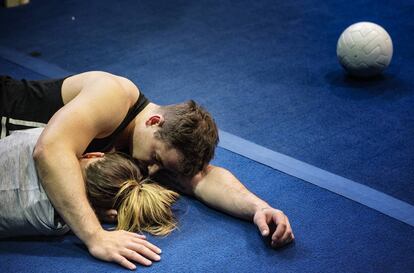
Cirque du Soleil has 60 people in their casting department as well as 20 talent scouts posted around the world. “I saw there was an audition, I went for it and it went well,” says Catalina Vega, one of the world’s top soccer freestylers, whose eye-watering agility with the ball has earned her a starring role in the show. “This is an opportunity you can’t miss because the gig could last for around 10 years,” she says. “But it does involve a lot of hours of work because we are not just freestylers, we do everything.”
Frenchman Gautier Fayolle, a seven-time world freestyler champion who will perform with Catalina, agrees. “This is a great experience because I have a trainer for the first time who guides me,” he says, catching his breath after performing a number of stunts. “It also means I can try out a lot of new things that I couldn’t try at home.”
It is impossible not to look heavenwards when you enter the vast Cirque du Soleil ‘Big Top’ in Montreal, where the sets have been created for this show. Everything appears to take place at vertiginous heights, such as the acrobatics performed by a young artist named Jimmy who is a former trampoline champion. “I had two dreams – to go to the Olympics and to get into Cirque du Soleil, an ambition I had after seeing the Alegria show many years ago,” he says. “Fortunately, one of the two has come true.”
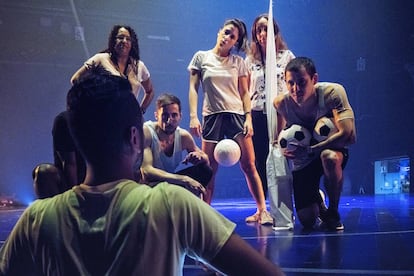
After hours of rehearsals, all the artists gather in the dining room. “How do we look?” asks Noé Chemel, a Belgian trampoline champion and Europe’s number three in 2014. His mother thought jumping would take the edge off his hyperactivity.
Another artist keen to know how the show is shaping up is the Ethiopian contortionist Malik, who can bend his body in ways that defy reason.
All the artists are eager for feedback from people other than their trainers. “We are so used to this routine that the things we do seem almost normal,” says Nacho Ricci, an Argentine who specializes in the corde lisse – a vertical rope – and who is looking forward to the premiere in Barcelona so that his friends can come and see him in action. Ricci landed the gig after years of talks and emails that concluded in an offer dependent on a video audition. “They asked me to show specific skills and also to perform some hip hop, something I had never done before. But I guess I got what I wanted,” he says.

Once the artists have been taken on board, Cirque de Soleil puts the machinery in gear. “We do everything in depth,” says McKeown,” because it’s the detail that makes the difference.”
First, after arriving at the talent factory in Montreal, the successful candidates undergo all kinds of physical and psychological examinations to check whether they need any minor surgery and to see how they perform under stress. They also take measurements for the costumes they will wear – Cirque du Soleil has its own sewing studio with 300 permanent employees.
“We run up 16,000 costumes and make 1,200 pairs of shoes a year,” says James Lavoie. “But for this show we will only use 165 different pieces. I think we are creating our own version of a soccer universe through our clothes.”
Lavoie shows off a costume made from natural grass as well as a pair of trousers that give the impression of being pixelated as though the wearer was on TV. “Messi tells us which ones he prefers, but we know that he has approved them all,” Lavoie adds.
The size of the sewing operation is matched by the rest of the Cirque du Soleil headquarters, which cover 36,000 square meters. There is a make-up room that offers 60 hours of courses while other spaces are used to prepare the acrobats, many of whom have never had any training in theater or choreographies, nor worked on facial expression.
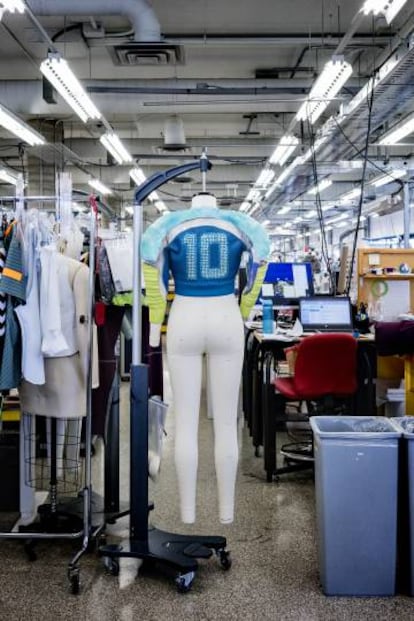
In order to enter this Messi world, it is necessary to go through the door to Les Studios Gilles Ste-Croix – named after one of the Cirque Du Soleil’s founders. This is a 20-meter-high pavilion that is still not big enough for the main act; in Barcelona, the premiere will take place in the immense Parc del Fòrum, which is more than 40 meters long and 27 meters wide. The aim is to replicate a soccer pitch with the spectators sitting around it. Preparations started on August 16 when ships carrying the necessary structures and materials left Canada for Barcelona. And as Messi stipulated, the end result will be unique.
“We are not a traditional circus; rather, we create acts that have never been done before,” says Igor, one of the show’s main trainers. He made his career at the Moscow Circus and comes from a family of circus performers. “The key is to combine soccer with our artistry, and I believe we have succeeded because, as far as I’m concerned, this is the best show I’ve ever seen – partly because of the level we have aimed for and partly because of the response of the protagonists.”
It is also thanks to the director, Mukhtar, who is crazy about soccer and Manchester United. “When they asked me to direct the show, my wife said, ‘This is just so you can watch more soccer, isn’t it?’ And I replied, ‘Hell, no! This is my show!’ Although inside I was thinking, ‘The hardest thing will be to create a spectacle that lives up to the world’s best player’.”
But this thought doesn’t hamper any of the acrobats involved in Messi10. “Looking around, everyone excels at what they do,” adds Mukhtar. “We are playing in the big leagues. The circus, like soccer, is hard work. You get it wrong and you start again. You practice until it’s perfect. You don’t get to be number one without putting in the effort.”

But sometimes things do go wrong, and there is always the risk of injury. “This is a risky business,” says Igor, who is working with the freestylers. But Jimmy, who has just performed a series of jumps from a swing, adds: “It’s something we don’t think about. If we did, we wouldn’t even try to do it.”
Meanwhile, Yang Huang, who started balancing acts at the age of seven because her mother didn’t want her simply playing with a ball, explains how she prepares herself mentally. “I put on music to stay alert and keep my mind clear. Otherwise, you make mistakes.”
In the event of injury, Cirque de Soleil has a team of physiotherapists on hand. “It’s very difficult for people putting themselves at risk every day and pushing their bodies to the limit not to injure themselves,” says Mariana, a Brazilian physiotherapist who left the Cirque du Soleil to attend to injuries at the Brazil Olympics in 2016, but who is now back for the Messi10 show. “There are all kinds of injuries but we work a lot in prevention so that when they do happen, they are not so pronounced and don’t take so long to heal.”
With prevention in mind, Cirque Du Soleil has decided to innovate and is working with RealTrack Systems, a physical activity monitoring system devised by a Spanish-based company using Wimu, a wifi data collection device used by Barça players, including Messi, to measure acceleration, speed and distance as well as heart rate and physical ability. “It’s new and we don’t know if it’s going to work,” says Mariana. “But it seems as though we can get data that helps to improve the artists’ performance. We will see what the results are, then decide if we will work with them going forward.”
“We always have a plan B in case someone gets injured or sick on the day of the show,” says McKeown. “We try to have at least one understudy for each artist because you never know what kind of injury they could get and how long they will be out of action. But if there’s one thing we know is that in this world, the show must go on.”
And this is about Messi: “The story of a youngster with an ambition that made him overcome all obstacles to become the best Number 10 in history,” according to the promotional material for the show.
“But we want to explain that the 10 could be anyone – a doctor, a lawyer,” Mukhtar adds. “It’s about someone having a dream and making it come true through work and commitment.”
There is, however, only one Messi – just as there is only one Cirque du Soleil. And together they have created something extraordinary.
English version by Heather Galloway.


